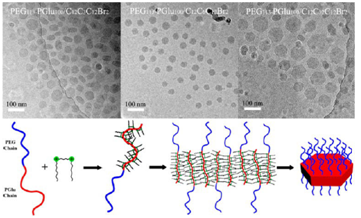 研究进展
研究进展
- Surface grafted semiconductor layer via surface initiated ring-opening polymerization of L-lysine NCA derivatives
- Tunable Organogelator from Alkyl-Polypeptide Diblock Prepared by Ring-Opening Polymerization
- Irreversible Low Critical Solution Temperature Behaviors of Thermal-responsive OEGylated Poly(L-cysteine) Containing Disulfide Bonds
- Fibril Aggregates Formed by a Glatiramer-Mimicking Random Copolymer of Amino Acids
- New thermal-responsive polymers based on alanine and (meth)acryl amides
- Oxidation-responsive OEGylated poly-L-cysteine and solution properties studies
- Supramolecular Hydrogels Assembled from Nonionic Poly(ethylene glycol)-b-Polypeptide Diblock Containing OEGylated Poly-L-glutamate
- Effects of the surface charge on the stability of PEG-b-PCL micelles: simulation of the interactions between charged micelles and plasma components
- Surface-Induced Hydrogelation Inhibits Platelet Aggregation
- Stimuli-responsive polypeptide materials prepared by ring-opening polymerization of α-amino acid N-carboxyanhydrides
- Effects of molecular weight on thermal responsive property of PEGylated poly-L-glutamates
- Facile Synthesis of Dendrimers Combining aza-Michael Addition with
- Peptide Hydrogels Assembled from Nonionic Alkyl-polypeptide Amphiphiles Prepared by Ring-Opening Polymerization
- Synthesis of toothbrush copolypeptides based on polylysine backbone
- One-step synthesis of water dispersible silica nanoplates
- Conformation-specific Self-assembly of Thermo-responsive Poly(ethylene glycol)-b-polypeptide Diblock Copolymer
- Coassembly of Poly(ethylene glycol)-block-Poly(glutamate sodium)
- Thermoresponsive Oligo(ethylene glycol) Functionalized Poly‑L‑cysteine
 研究进展
研究进展
Coassembly of Poly(ethylene glycol)-block-Poly(glutamate sodium) and Gemini Surfactants with Different Spacer Lengths
Yuchun Han, Wentao Wang, Yongqiang Tang, Shusheng Zhang, Zhibo Li,* and Yilin Wang*
Langmuir 2013, 29, 9316−9323
The coassembly of poly(ethylene glycol)-b-poly-(glutamate sodium) copolymer (PEG113-PGlu100) with cationicgemini surfactants alkanediyl-α,ω-bis-(dodecyldimethylammoniumbromide) [C12H25(CH3)2N(CH2)SN(CH3)2C12H25]Br2 (designated as C12CSC12Br2, S = 3, 6, and 12) have been studied by isothermal titration microcalorimetry, cryogenic transmission electron microscopy, circular dichroism, small-angle X-ray scattering, zeta potential, and size measurement. It has been shown that the electrostatic interaction of C12CSC12Br2 with the anionic carboxylate groups of PEG113-PGlu100 leads to complexation, and the C12CSC12Br2/ PEG113-PGlu100 complexes are soluble even at the electroneutral point. The complexes display the feature of superamphiphiles and assemble into ordered nanosheets with a sandwich-like packing. The gemini molecules which were already bound with PGlu chains associate through hydrophobic interaction and constitute the middle part of the nanosheets, whereas the top and bottom of the nanosheets are hydrophilic PEG chains. The size and morphology of the nanosheets are affected by the spacer length of the gemini surfactants. The average sizes of the aggregates at the electroneutral point are 81, 68, and 90 nm for C12C3C12Br2/ PEG113-PGlu100, C12C6C12Br2/ PEG113-PGlu100, and C12C12C12Br2/ PEG113-PGlu100, respectively. Both C12C3C12Br2/ PEG113-PGlu100 and C12C12C12Br2/ PEG113-PGlu100 mainly generate hexagonal nanosheets, while the C12C6C12Br2/ PEG113-PGlu100 system only induces round nanosheets.
